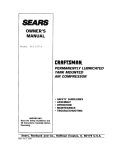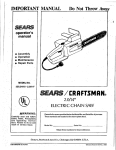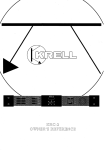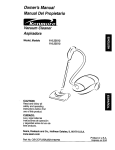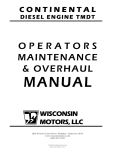Download Craftsman Air Compressor Troubleshooting guide
Transcript
SEARS GENERAL MANUAL CRAFTSMAN FOR PERMANENTLY LUBRICATED TANK MOUNTED AIR COMPRESSOR NOTE: For identificationof Repair Parts, see separate Parts List Manual. Record in the spaces provided. (1) The model number which can be found on the maintenance label on the top of the motor cover or on the tank. (2) The code number which can be found on the small bar code label on the rear of the air tank. (3) The Manufacturers Number is located on the metal data plate which is welded onto the backside of the air tank. (This data plate is painted the same color as the tank.) Retain these numbers for future reference. SAFETY GUIDELINES i ASSEMBLY ;rOPERATION i MAINTENANCE i IMPORTANT: Read the Safety Guidelines and All Instructions Carefully Before Operating i TROUBLESHOOTING i REPAIR PARTS Sears, I MG1-OILFREE 9/17/941 Roebuck Model No. Code No. Mfg. No. and Co., Hoffman Estates, IL 60179 U.S.A. TABLE OF CONTENTS Page WARRANTY ............................................................................................................................... 2 SAFETY GUIDELINES 3 ................................................................................................................ WARNING CHART ...................................................................................................................... 3 GLOSSARY 5 ............................................................................................................................... ACCESSORIES FOR USE WITH SEARS AIR COMPRESSORS GENERAL INFORMATION ................................................. .......................................................................................................... 5 5 DESCRIPTION OF OPERATION .................................................................................................. 6 ASSEMBLY 7 ............................................................................................................................... INSTALLATION AND BREAK-IN PROCEDURES ......................................................................... Location of Air Compressor ................................................................................................... Lubrication and Oil ................................................................................................................ Extension Cords ................................................................................................................... Voltage and Circuit Protection ............................................................................................... Grounding Instructions .......................................................................................................... Break-in Procedure ............................................................................................................... 7 7 7 7 7 8 8 OPERATING PROCEDURES ...................................................................................................... 9 MAINTENANCE ......................................................................................................................... Air Filter- Inspection and Replacement ................................................................................ CheckValve-Replacement .................................................................................................. Safety Valve - Inspection ...................................................................................................... Motor .................................................................................................................................. Storage ............................................................................................................................... 10 10 10 10 10 10 TROUBLESHOOTING GUIDE ..................................................................................................... 11 HOWTO ORDER REPAIR PARTS ............................................................................................. 16 FULL ONE YEAR WARRANTY ON AIR COMPRESSORS If this air compressor fails due to a defect in material or workmanship within one year from the date of purchase, RETURN IT TO THE NEAREST SEARS SERVICE CENTER/DEPARTMENT THROUGHOUT THE UNITED STATES AND SEARS WILL REPAIR IT, FREE OF CHARGE. If this air compressor of purchase. is used for commercial or rental purposes, the warranty will apply for ninety days from the date This warranty gives you specific legal rights and you may have other rights which vary from state to state. Sears, Roebuck and Co., Hoffman Estates, IL 60179 U.S.A. SAFETY GUIDELINES This manual contains information that is important foryou to know and understand. This information relatesto protecting YOUR SAFETY and PREVENTING EQUIPMENT PROBLEMS. To help you recognize this information, we use the following symbols, Please read the manual and pay attention to these sections. URGENT SAFETY INFORMATION -A HAZARD THAT WILL CAUSE SERIOUS INJURY OR LOSS OF LIFE. IMPORTANT SAFETY INFORMATION A HAZARD THAT MIGHT CAUSE SERIOUS INJURY OR LOSS OF LIFE. NOTE Information equipment. for HAZARDS preventing CAN damage OCCUR PLEASE WHAT TO LOOK FOR to Information that you should pay special attention to. IF EQUIPMENT READ THE IS NOT FOLLOWING WHAT COULD HAPPEN HOW USED PROPERLY. CHART. TO PREVENT IT Hot Parts The metal compressor components such as manifold, tubes, etc. become hot when the air compressor is running. If you touch them, you may be seriously burned. Avoid contact with metal components of the compressor during or immediately after operation. Reaching under or removing portions of the plastic enclosures such as the console cover exposes hot surfaces. Allow compressor to cool prior to servicing. Flammable Vapors It is normal for the motor and pressure switch to spark when compressor starts or stops. A spark can ignite vapors from gasoline or solvents, causing a fire or explosion. If spraying a flammable material, provide ample ventilation. Never spray in a closed area. There must be a flow of fresh air at all times. Always operate the air compressor in well-ventilated areas, free of gasoline or other solvent vapors. Do not operate the compressor near the spray area. Air Tank Modifications to air compressor components in an attempt to reach higher air pressure can cause the air tank to rupture or explode. Do not adjust, remove or tamper with the safety valve or pressure switch. If safety valve or pressure switch replacement is necessary, a part with the same ratings must be used. Incompatabitity between tank and compressor cause the tank to rupture. Never replace the air tank with a different model or a larger tank. Return to Authorized Service Center if replacement is required. will Modifications to the air tank will cause it to weaken. Never drill into, weld or in any way modify the air tank. The tank may rupture or explode. If leaks develop due to corrosion or tank is damaged, return to Authorized Service Center for replacement. SAFETY GUIDELINES WHATTO LOOK FOR Compressed Air WHATCOULD HAPPEN Compressad air can propel dust, dirt or loose particles it comes in contact with. These propelled particles may cause serious injury or damage. HOWTO PREVENT IT Never point any nozzle or sprayer toward a person or any part of the body. Always wear safety goggles or glasses when using the air compressor. Always turn the air compressor or removing accessories. Too much air pressure applied to air tools or accessories can cause damage or risk of bursting. Electricity Your air compressor is powered by electricity. Like any other electdca;_y powered device, if it is not used properly it may cause electrical shock. off before attaching Check the manufacturer's pressure rating for air tools and accessories. Regulator outlet pressure must never exceed the maximum pressure rating. Always unplug the air compressor nance or repair. Never use the air compressor raining. prior to mainte- outdoors when it is Always plug the cord into an electrical outlet with the specified voltage and adequate fuse protection. Toxic Vapors It is normal for compressed air to contain toxic or irritating vapors. Such vapors are harmful if inhaled. Never directly inhale the compressed this unit. Certain materials you are spraying (like paint, weed killer, sand or insecticide) can be harmful if you inhale them. Read labels and safety data for all materials you spray. Follow all safety precautions. air produced by Use a mask or respirator if there is a chance of inhaling toxic sprayed materials. Masks and respirators have limits and will only provide protection against some kinds and limited amounts of toxic material. Read mask and respirator instructions carefully. Consult with a safety expert or industrial hygienist if you are not sure about the use of a certain mask or respirator. Unsuitable Solvents The solvents 1,!,1 - Trichloroethane and Methylene Chloride can chemically react with aluminum used in paint spray guns, paint pumps, etc., and cause an explosion. These solvents can also react with galvanized components and cause corrosion and weakening of parts. This does not affect your air compressor - but it may affect the equipment being used. If the material you intend to spray contains the solvents listed at left (read the label or data sheet), do not use accessories that contain aluminum or galvanized parts. You must either change the material you intend to spray, or use only stainless steel spray equipment. GLOSSARY CFM: Cubicfeet perminute, SCFM: Standard cubic feet per minute; a unit of measure ofairdelivery. PSIG: Pounds per square inchgauge; a unit of measure of pressure. AS ME: Amedcan Society of Mechanical Engineers; made, tested, inspected and registered to meet the standards of the ASME. U.L. Listed: This product is Listed by Underwriters Laboratories, Inc. (UL). Samples of this product have been evaluated by UL and meet applicable UL Standards for Safety. Cut-In Pressure: While the motor is off, airtank pressure drops as you continue to use your accessory. When the tank pressure drops to a certain low level the motor will restart automatically. The low pressure at which the motor automatically re-starts is called "cut-in pressure." Cut-Out Pressure: When you turn on your aircompressor and it begins to run, air pressure in the air tank begins to build. It buildsto a certain high pressure before the motor automatically shuts off - protecting your air tank from pressure higher than its capacity. The high pressure at which the motor shuts off is called "cut-out pressure." ACCESSORIES FOR USE WITH SEARS AIR COMPRESSORS •SPRAY GUNS ,BLOWGUNS •AIR CAULKING GUNS •PNEUMATIC POWER WASHERS .SANDBLASTERS •AIR BRUSHES •AIR LINE FI LTERS "TIREAIRCHUCKS °PAINTTANKS "AIRTANKS •INFLATOR KITS •QUICKCONNECTOR SETS (various sizes) .VISCOSIMETER •AIR PRESSURE REGULATORS -OIL FOG LUBRICATORS ,AIRTOOLS: Sanders Drills Impact Wrenches Hammers .AIRHOSE: 1/4", 5/16" or 3/8" I.D. in various lengths •NAI LER/STAPLERS Decking Farming Roofing Siding Finishing Carpentry Upholstery Picture Framing •DRAIN CLEANER -DUSTER GUN GENERAL INFORMATION You have purchased an air compressor unit consisting of a one cylinder, single-stage air compressor pump and air tank. included are an air hose, tire air chuck, wheels, regulator, gauges, and handle. This air compressor requires no oil. Nowyou can enjoy all the benefits of having an air compressorwithout ever having to purchase, add or change oil. Your air compressorcan be used for operating paint spray guns, air tools, caulking guns, grease guns, air brushes, sandblaster, or inflating tires and plastic toys, spraying weed killers, insecticides, etc. An air pressure regulator is required for most of the applications. An air filter which removes moisture and dirt from compressed air should be used where applicable. These accessories can be purchased from most Sears Parts Departments. DESCRIPTION OF OPERATION Air Compressor Pump: To compress air, the piston moves up and down in the cylinder. On the downstroke, air isdrawn in through the air intake valves. Th e exhaust valves remain closed. On the upstroke of the piston, air is compressed. The intake valves close and compressed air isforced outthrough the exhaust valves, through the outlet tube, throughthe check valve and intothe airtank. Working air is not available until the compressor has raised the air tank pressure above that required at the air outlet. Check Valve: When the air compressor is operating, the check valve is"open", allowing compressed airto enterthe air tank. When the air compressor reaches "cut-out" pressure,the checkvalve "closes", allowing air pressureto remain inside the air tank. Pressure Release Valve: The pressure release valve located on the side of the pressure switch, is designed to automatically release compressed air from the compressor head and the outlet tube when the air compressor roaches "cut-out" pressure or is shut off. Ifthe air is not released, the motor will not be able to start. The pressure release valve allows the motor to restart freely. When the motor stops running, airwill be heard escaping from the valve for a few seconds. No air should be leaking when the motor is running. Pressure Switch: The pressure switch automatically starts the motor when the air tank pressure drops below the factory set "cut-in" pressure. It stops the motor when the airtank pressure reaches the factory set"cut-out" pressure. Safety Valve: If the pressure switch does not shut off the air compressor at its cut-out pressure setting, the safety va lyewill protectthe tank against high pressure by"popping out" at its factory set pressure (slightly higher than the pressure switch cut-out setting). Regulator." The air pressure coming from the air tank is controlled by the regulator. Turn the regulator knob clockwise to increase pressure and counter-clockwise to decrease pressure. To avoid minor readjustment after making a change in pressure setting, always approach the desired pressure from a lower pressure. When reducing from a higher to a lowersetting, first reduce to some pressure less than that desired, then bring up to the desired pressure. Depending on the air requirements of each particular accessory, the outlet regulated air pressure may have to be adjusted while operating the accessory. Outlet Pressure Gauge: The outlet pressure gauge indicates the air pressure available at the outlet side of the regulator. This pressure iscontrolled bythe regulator and is always less or equal to the tank pressure. See "Operating Procedures". Tank Pressure Gauge: The tan k pressure gauge indicates the reserve air pressure in the tank. Cooling System: This compressor contains an advanced design cooling system. At the heart of this cooling system is an engineered fan. It is perfectly normal forthis fan to blow air through the vent holes in large amounts. You knowthat the cooling system is working when air is being expelled. Tools Needed for Assembly • a 9/16" socket or open end wrench for attaching the wheels • a 3/8" open end wrench or socket to tighten handle screws ASSEMBLY Installing Wheels, Handles, Rubber Foot Strip It will be necessary to brace or support one side of the outfit when installing the wheels because the compressor will have a tendency to tip. THE WHEELS AND HANDLE DO NOT PROVIDE ADEQUATE CLEARANCE, STABILITY OR SUPPORT FOR PULLING THE UNIT UP AND DOWN STAIRS OR STEPS. THE UNIT MUSTBE LIFTED, OR PUSHED UPA RAMP. . . Tighten securely. The outfit will sit level if the wheels are properly installed. Attach the handle to the compressor saddle by insertingthe handle inside the compressorsaddle and lining up the two bolt holes on each side. Install the four screws, two on each side. Tighten securely. INSTALLATION Location Clean and dry underside of air tank leg opposite wheels. Remove the protective paper strip from the adhesive backed rubber foot strip. Attach the rubber foot strip to the bottom of leg. Press firmly into place. AND BREAK-IN PROCEDURES of the Air Compressor Loca;.athe air compressorin a clean, dry and well ventilated area. The airfilter must be kept clear of obstructionswhich could reduce air delivery of the air compressor. The air compressor should be located at least 12" away from the wall or other obstructions that will interfere with the flow of air. The air compressor head and shroud are designed to allow for proper cooling. Lubrication • a 3-wire extension cord that has a 3-blade grounding plug, and a 3-slot receptacle that will accept the plug on the product • in good condition no Iongerthan 50 feet • 12 gauge (AWG) or larger. (Wire size increases as gauge number decreases. 10 AWG and 8 AWG may also be used. DO NOT USE 14 OR 16 AWG.) and Oil This unit needs no lubrication or oiling. Extension Install one shoulder bolt and one nut for each wheel. Cords Use extra air hose instead of an extension cord to avoid voltage drop and power loss to the motor, and to prevent overheating. Voltage and Circuit Protection Referto your Parts List Manual forthe voltage and circuit protction requirements of your compressor. Use only a fuse or circuit breaker that is the same rating as the branch circuit the air compressor is operated on. If the compressor is connected to a circuit protcted by fuses, use only dual RefertoPartsList Manual for your compressor. Certain air compressor models can be operated on a 15 amp circuit if: 1. Voltage supply to circuit is normal. 2. Circuit is not used to supply any otherelectdcal (lights, appliances, etc.). If repairing cord or plug, the grounding wire must be kept separate from the current-carrying wires. Never connect the grounding wire to a flat blade plug terminal. The grounding wire has insulation with an outer surface that is green-with or without yellow stripes. needs 3. Extension cords comply with specifications. 4. Circuit is equipped with a 15 amp circuit breaker or 15 amp time delay fuse. If these grounding instructions are not completely understood, or if in doubt as to whether the compressor is properly grounded, have the installation checked by a qualified electrician. 120 Volt Models If any of the above conditions cannot be met, orif operation of the compressor repeatedly causes interruption of the power, it may be necessary to operate it from a 20 amp circuit. It is not necessary to change the cord set. 240 Volt Models wlllte 1,, p PLU OUTL. n G.ouNoED 20 AMP PLUG OUTLET o.oo.o,._,I ;element time delay fuses, as noted in that Service Bulletin. GROUNDING PIN -7 PIN GROUNDING INSTRUCTIONS RISK OR ELECTRICAL SHOCK. In the event of a short circuit, grounding reduces the risk of shock by providing an escape wire for the electric current. This air compressor must be properly grounded. The portable air compressor is equipped with a cord having a grounding wire with an appropriate grounding plug. The plug must be used with an outlet that has been installed and grounded in accordance with all local codes and ordinances. The outlet must have the same configuration as the plug. DO NOT USEAN ADAPTER. Inspect the plug and cord before each use. Do not use if there are signs of damage. Break-in Procedure Serious damage may result if the following break-in instructions are not closely followed. This procedure is required only once, before the air compressor is put into service. 1. 2. 3. 4. IMPROPER GROUNDING CAN RESULT IN ELECTRICAL SHOCK. 5. Do not modify the plug that has been provided. If it does not fit the available outlet, the correct outlet should be installed by a qualified electrican. 6. Set the pressure switch OFF/AUTO lever in the "OFF" position. Plug the power cord into the correct branch circuit receptacle. Turn the regulator clockwise, opening it fully, to prevent air pressure build-up in the tank. Movethe OFF/AUTO leverto"AUTO". Thecompressor will start. Run the compressor for 15 minutes. Make sure the regulator is open and there is no tank pressure buildup. After 15 minutes, close the regulator by turning it counterclockwise. The air tank will fill to cut-out pressure and then the motor will stop. Refer to "Operating Procedures". OPERATING . 2. PROCEDURES Before attaching air hose or accessories, make sure the OFF/AUTO lever is set to "OFF" and the air regulator is closed. Compressed air from the outfit may contain water condensation. Do not spray unfiltered air at an item that could be damaged. Some air operated tools or devices may require filtered air. Read the instructions for the air tool or device. . . Check the manufacturer's maximum pressure rating for air tools and accessories. The regulator outlet pressure must never exceed the maximum pressure rating. If your compressor is not supplied with a regulator with gauge, install one before using accessories. the compressor When you are finished: 7. Set the "OFF/AUTO" 8. 9. near the spray lever to "OFF". Turn the regulator counterclockwise let pressure to zero. Remove the air tool or accessory. and set the out- 10. Open the regulator and allow the air to slowly bleed from the tank. Close theregulator when tank pressure is approximately 20 psi. 11. Drain water from air tank. WATER WILL CONDENSE IN THE AIR TANK. IF NOT DRAINED, WATER WILL CORRODE AND WEAKEN THE AIR TANK CAUSING A RISK OF AIR TANK RUPTURE. With tank pressure at approximately drain cock or drain valve. 20 psi, open the NOTE: If drain cock valve is plugged, release all air pressure. The valve can then be removed, cleaned, then reinstalled. Turn the OFF/AUTO lever to "AUTO" and allow tank pressure to build. Motor will stop when tank pressure reaches "cut-out" pressure. Open the regulator by turning it clockwise. Adjust the regulator to the correct pressure setting. Your compressor is ready for use. Always operate the air compressor in well-venti lated areas; free of gasoline or other solvent vapors. Do not operate area, Attach hose and accessories, TOO MUCH AIR PRESSURE CREATES A HAZARDOUS RISK OF BURSTING. CAREFULLY FOLLOW STEPS 3 AND 5 EACH TIME THE COMPRESSOR IS USED, . 6. 12. After the water has been drained, close drain cock or drain valve. The air compressor can now be stored. MAINTENANCE UNITCYCLESAUTOMATICALLYWHEN POWERIS ON. WHEN DOING MAINTENANCE, YOU MAY BE EXPOSEDTOVOLTAGE SOURCES, COMPRESSEDAIRORMOVING PARTS. PERSONALINJURIESCANGCCUR. BEFORE PERFORMINGANY MAINTENANCE OR REPAIR, UN PLUG THE COMPRESSORAN D BLEED 0 FFALLAIR PRESSURE. ALL MAINTENANCE Air Filter- Inspection and AND REPAIR OPERATIONS NOT LISTED MUST BE DONE BY QUALIFIED SERVICE PERSONNEL. Replacement Hot surfaces. Risk of burn. Compressor heads are exposed when filter cover removed° Allow compressor to cool prior to servicing. Filte__ Safety is Valve - inspection If the safety valve does not work properly, over-pressurization may occur, causing air tank rupture or an explosion. Before starting compressor, pull the ring on the safety valve to make sure that the safety valve operates freely. If the valve is stuck or does not operate smoothly, it must be replaced with the same type of valve. Filter Retainer Keep the air filter clean at all times. Do not operate the compressorwith the air filter removed. A dirty air filterwill not allowthe compressor to operate at full capacity. Beforeyou usethe compressor, checkthe air filter to be sure it is clean. CheckYalve - Replacement Before servicing: • Unplug or disconnect electrical compressor. •Bleed tank of pressure. •Allow compressor to cool. 1. 2. 3. 4. 5. supply to Release all air pressure from airtank and unplug outfit. Removeshroud. Loosen the top and bottom nuts and remove the outlet tube. Removethe pressure releasetube and fitting. Unscrewthe check valve (turn counterclockwise) using a socket wrench. 6. Checkthatthevalve disc moves freely insidethe check valve and that the spring holds the disc in the upper, closed position. The check valve may be cleaned with a solvent, such as paint and varnish remover. 7. Apply sealant tothe check valve threads. Reinstall the checkvalve (turn clockwise). 8. Replace the pressure release tube and fitting. 9. Replace the outlet tube and tighten top and bottom nuts. 10. Replace the shroud. 10 Motor The motor has an automatic reset thermal overload protector, tf the motor overheats for any reason, the overload protectorwill shut offthe motor. The motor must be allowed to cool down before restarting. The compressor will automatically restart after the motor cools. If the overload protectorshuts the motor off frequently, check for a possible voltage problem. Lowvoltage can also be suspected when: 1. The motor does not get up to full power or speed. 2. Fusesblowout whenstartingthemotor;lightsdim Storage Before you store the air compressor, make sure you do the following: t. 2. Reviewthe"Maintenance"and"Operating Procedures" sections and perform maintenance as necessary. Be sure to drain water from the air tank. Protect the electrical cord and air hose from damage (such as being stepped on or run over). Wind them loosely around the compressor handle. Store the air compressor in a clean and dry location. TROUBLESHOOTING GUIDE PERFORMING REPAIRS MAY EXPOSE VOLTAGE SOURCES, MOVING PARTS OR COMPRESSED AIR SOURCES. PERSONAL INJURY MAY OCCUR. PRIOR TO ATTEMPTING ANY REPAIRS, UNPLUG THE COMPRESSOR AND BLEED OFF TAN K AIR PRESS URE. PROBLEM CAUSE CORRECTION Pressure switch does not shut off motor when compressor reaches "cut-out" pressure. Move the pressure switch lever to the "OFF" position. If the outfit doesn't shut off, and the electrical contacts are welded together, replace the pressure switch. Pressure switch "cut-out" too high, Return the outfit to Sears Service Center to check and adjust, or replace switch. Air leaks at fittings. Tube fittings are not tight enough. Tighten fittings where air can be heard escaping. Check fittings with soapy water solution. DO NOT OVERTIGHTEN. Air leaks at pressure switch release valve, Defective valve. Remove Excessive tank pressure - safety valve pops off. pressure switch release and replace the release valve. Check to see if the pin in the bottom of the pressure release valve is stuck. If it does not move freely, replace the valve. Air leaks in air tank or at air tank welds. Defective flappervalve in manifold. A defective flapper valve results in a constant air leak at the pressure release valve when there is pressure in the tank and the compressor is shut off. Remove and clean or replace valve. Check valve seat damaged. Inspect and replace upper manifold assembly. Defective air tank. Air tank must be replaced. Do not repair the leak. DO NOT DRILL INTO, WELD OR OTHERWISE MODIFY AIR TANK OR IT WILL WEAKEN, THE TANK CAN RUPTURE OR EXPLODE. Air leaks between valve plate. Pressure lated when reading head and on the regu- pressure gauge drops an accessory is used, Leaking seal. It is normal for "some" pressure drop to occur. _ Torque head screws leak, replace seal to 8 ft. Ibs. If this does not stop If there is an excessive amount of pressure drop when the accessory is used, adjust the regulator following the instructions on page 6. NOTE Adjust the regulated tions (while accesory pressure is being under flow condiused). 11 TROUBLESHOOTING GUIDE (Continued) PROBLEM CAUSE CORRECTION Air leak from safety valve. Possible defect in safety valve. Operate safety valve manually by pulling on ring. If valve still leaks, it should be replaced. Knocking Defective check valve. Remove and clean, or replace. Prolonged excessive use of air. Decrease amount of air usage. Compressor is not large enough for air requirement. Check the accessory air requirement. If it is higher than the SCFM or pressure supplied by your air compressor, you need a larger compressor. Restricted air intake filter. Clean or replace air intake filter. Do not operate the air compressor in the paint spray area. Hole in hose. Check and replace if required. Check valve Noise Compressor is not supplying enough air to operate accessories. Air Motor will not run or restart. restricted. Remove and clean, or replace. leaks. Tighten fAings. (See Air Leaks Section bleshooting Guide.) of Trou- Motor ovedoad protection switch has tripped. Let motor cool off and overload switch will automatically reset. Tank pressure exceeds switch "cut-in" pressure. Motor will start automatically when tank pressure drops below "cut-in" pressure of pressure switch. pressure Wrong gauge wire or length of extension cord. Check for proper gauge wire and cord length. Check valve stuck open. Remove and clean, or replace. Loose Check wiring connection terminal box area. Possible electrical connections. defective motor or capacitor. inside pressure switch and Return to Sears Service Center for inspection replacement, if necessary. Paint spray on internal motor parts. Have checked at Sears Service Center. Do not operate the compressor in the paint spray area. See flammable vapor warning. Fuse blown, circuit breaker tripped. 1. 2. 3. 4. Pressure switch sure. release has not valve unloaded on Check fuse box for blown fuse and replace, if necessary. Reset circuit breaker. Do not use a fuse or circuit breaker with higher rating than that specified for your particular branch circuit. Check for proper fuse. Only time delay fuses are acceptable. Check for low voltage conditions and/or proper extension cord. Disconnect the other electrical appliances from circuit or operate the compressor in its own branch circuit. pressure head pres- Broken exhaust valve. Bleed the line by pushing the lever on the pressure switch to the "off" position; if the valve does not open, replace it. Inspect and replace if necessary. / Regulator knob continuous air I Dirty or damaged leak. Regulator will not shut off /. parts. at air outlet. ! } .............. 12 i or regulator internal Clean or replace regulator, or internal parts. SERVICE NOTES 13 SERVICE 14 NOTES SERVICE NOTES 15 SEARS PARTS MANUAL CRAFTSMAN PERMANENTLY LUBRICATED AIR COMPRESSOR MODEL NO. The model number of your Sears Compressor can be found on the label which is located on the top of the shroud. IF YOU NEED REPAIR PART5: REPAIR For Replacement Parts Ordering, Call This Toll-Free Number: 1-800-366-PART (1-800-366-7278) SERVICE Now that you have purchased your Sears Craftsman Air Compressor, should a need ever exist for repair service, simply take it to any Sears Repair Center. For The WHEN ORDERI NG REPAIR PARTS, ALWAYS GIVE THE FOLLOWING INFORMATION: Location Of A Sears You, Call This Toll-Free Repair Center Near Number: 1-800-488-1222 •MODEL NUMBER, •PART NUMBER. •PART DESCRIPTION. •NAME OF ITEM. FULL ONE YEAR WARRANTY AIR COMPRESSORS If this air compressor fails due to a defect in material or workmanship within one year from the date of purchase, RETURN IT TO THE NEAREST SEARS REPAIR CENTER THROUGHOUT THE UNITED STATES AND SEARS WILL REPAIR IT, FREEOF CHARGE. Ifthisair compressoris used for commercialor rental purposes, the warranty will apply for ninety days from the date of purchase. This warranty gives you specific legal rights and you may have other rights which vary from state to state. Sears, Roebuck and Co., Hoffman Estates, IL 60179 U.S.A.
















